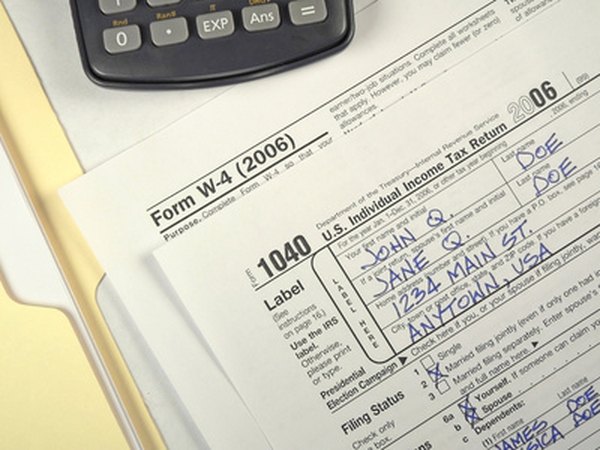How Much Should I Save From Each Paycheck for Taxes When Working for a 1099?
Make quarterly estimated tax payments on 1099 income.
tax forms image by Chad McDermott from Fotolia.com
If you are self-employed or work as a non-employee contractor, your earnings are not subject to federal or state withholding requirements. Since the U.S. tax system is a pay-as-you-go system, the Internal Revenue Service expects you to make quarterly estimated tax payments throughout the year, rather than pay your full tax due when you file your federal return. Set aside a portion of your non-employee income as you earn it based on your previous year's total tax liability to make your estimated quarterly payments. For many taxpayers, this amount typically is around 30 percent,
Tip
If you make quarterly payments totaling the amount of tax you owed the previous year, you can generally avoid owing the IRS a penalty, though you can still owe additional tax or find yourself overpaying the IRS. A rule-of-thumb percentage to set aside each pay period is 30 percent.
Freelancer and Independent Contractor Taxes
If you are working as an independent contractor, you are responsible for filing your own taxes. The IRS penalizes taxpayers who have a balance due of over $1,000 when they file returns, unless you've paid at least as much tax during the year as you owed the previous year or 90 percent of what you owe for the current tax year. The easiest way to avoid such a penalty is to pay what you owed last year, in four quarterly payments sent in with Form 1040-ES. If your income or deductions are substantially different from last year, another method may be more advantageous.
The due dates are April 15 for taxes on income earned during the first quarter of the year, then June 15, Sept. 15 and Jan. 15, or the next business day. If you file your full-year return by April 15 you do not need to make a fourth-quarter estimated payment. You may pay the full amount in any combination of payments, spread out over the year.
At the end of the year, anyone who paid you at least $600 for work as a contractor is required to send you an IRS 1099 MISC Form outlining what you paid and send a copy to the IRS. Verify these forms match your records and include them with your tax return.
Other Considerations in Estimating Taxes
If your earnings or deductions will be drastically different from the previous year, or if your earnings fluctuate throughout the year, estimate your profit separately each quarter. Add up your income and subtract your deductible expenses for the quarter. Calculate that quarter's estimated tax payment based on your expected tax bracket, included in worksheets with Form 1040-ES. You'll calculate the tax liability for the year-to-date and can adjust the amount paid if you find you are ahead or behind the amount owed.
Include other sources of income such as interest, dividends or capital gains, and deductions for exemptions, standard deductions or any tax credits for which you may qualify. Some special independent contractor deductions include a home office you may maintain, use of your vehicle for tax purposes and the cost of health insurance, if you can't get it through your employer or your spouse's employer.
Using the detailed estimated worksheets provided by the IRS will allow you a relatively accurate method for both estimating and paying your quarterly payments. Married taxpayers will need to incorporate a spouse's income and withholding when calculating estimated taxes.
2019 Tax Law
In 2019, the standard deduction increased to $24,400 (married filing jointly), $12,200 (single and married filing separately) and $18,350 (head of household), and tax brackets changed, generally imposing less tax liability. You may wish to take these changes into account in estimating your tax liability to avoid paying too much to the IRS.
2018 Small Business Tax Change
A 2018 tax change that wasn't available in 2017 was a 20 percent deduction for some small businesses. This deduction is available on much income obtained through pass-through businesses, meaning those whose earnings are taxed on their owners' tax returns rather than their own. That applies to many self-employed people who maintain partnerships or sole proprietorships, so it may substantially reduce your tax liability if you're self-employed. Some restrictions on income amount and other factors do apply.
References
- Internal Revenue Service Publication 505: Tax Withholding and Estimated Tax
- IRS: Estimated Taxes
- Forbes: New: IRS Announces 2018 Tax Rates, Standard Deductions, Exemption Amounts And More
- IRS: Form 1099-MISC
- Kiplinger: Tax Deductions for Independent Contractors
- Tax Policy Center: Navigating The TCJA’s Pass-Through Deduction
- Bench: How Much to Set Aside for Small Business Taxes
- IRS: IRS Provides Tax Inflation Adjustments for Tax Year 2019
Resources
Writer Bio
Naomi Smith has been writing full-time since 2009, following a career in finance. Her fiction has been published by Loose Id and Dreamspinner Press, among others. She holds a Master of Science in financial economics from the London School of Economics and a Bachelor of Arts in political economy from the University of California, Berkeley.

